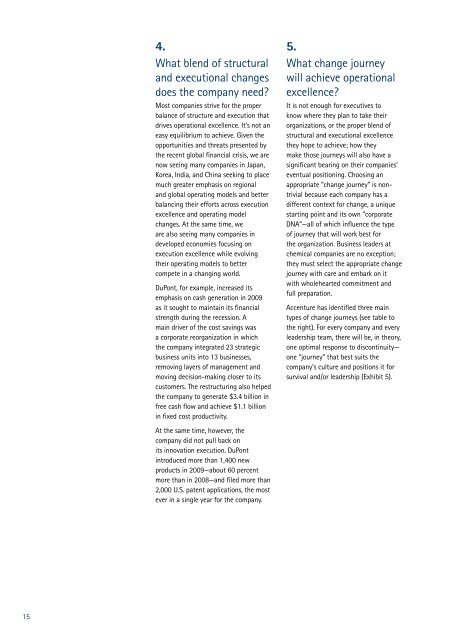Achieving Operational Excellence: Five Elements of Success in the ...
Achieving Operational Excellence: Five Elements of Success in the ...
Achieving Operational Excellence: Five Elements of Success in the ...
Create successful ePaper yourself
Turn your PDF publications into a flip-book with our unique Google optimized e-Paper software.
15<br />
4.<br />
What blend <strong>of</strong> structural<br />
and executional changes<br />
does <strong>the</strong> company need?<br />
Most companies strive for <strong>the</strong> proper<br />
balance <strong>of</strong> structure and execution that<br />
drives operational excellence. It’s not an<br />
easy equilibrium to achieve. Given <strong>the</strong><br />
opportunities and threats presented by<br />
<strong>the</strong> recent global f<strong>in</strong>ancial crisis, we are<br />
now see<strong>in</strong>g many companies <strong>in</strong> Japan,<br />
Korea, India, and Ch<strong>in</strong>a seek<strong>in</strong>g to place<br />
much greater emphasis on regional<br />
and global operat<strong>in</strong>g models and better<br />
balanc<strong>in</strong>g <strong>the</strong>ir efforts across execution<br />
excellence and operat<strong>in</strong>g model<br />
changes. At <strong>the</strong> same time, we<br />
are also see<strong>in</strong>g many companies <strong>in</strong><br />
developed economies focus<strong>in</strong>g on<br />
execution excellence while evolv<strong>in</strong>g<br />
<strong>the</strong>ir operat<strong>in</strong>g models to better<br />
compete <strong>in</strong> a chang<strong>in</strong>g world.<br />
DuPont, for example, <strong>in</strong>creased its<br />
emphasis on cash generation <strong>in</strong> 2009<br />
as it sought to ma<strong>in</strong>ta<strong>in</strong> its f<strong>in</strong>ancial<br />
strength dur<strong>in</strong>g <strong>the</strong> recession. A<br />
ma<strong>in</strong> driver <strong>of</strong> <strong>the</strong> cost sav<strong>in</strong>gs was<br />
a corporate reorganization <strong>in</strong> which<br />
<strong>the</strong> company <strong>in</strong>tegrated 23 strategic<br />
bus<strong>in</strong>ess units <strong>in</strong>to 13 bus<strong>in</strong>esses,<br />
remov<strong>in</strong>g layers <strong>of</strong> management and<br />
mov<strong>in</strong>g decision-mak<strong>in</strong>g closer to its<br />
customers. The restructur<strong>in</strong>g also helped<br />
<strong>the</strong> company to generate $3.4 billion <strong>in</strong><br />
free cash flow and achieve $1.1 billion<br />
<strong>in</strong> fixed cost productivity.<br />
At <strong>the</strong> same time, however, <strong>the</strong><br />
company did not pull back on<br />
its <strong>in</strong>novation execution. DuPont<br />
<strong>in</strong>troduced more than 1,400 new<br />
products <strong>in</strong> 2009—about 60 percent<br />
more than <strong>in</strong> 2008—and filed more than<br />
2,000 U.S. patent applications, <strong>the</strong> most<br />
ever <strong>in</strong> a s<strong>in</strong>gle year for <strong>the</strong> company.<br />
5.<br />
What change journey<br />
will achieve operational<br />
excellence?<br />
It is not enough for executives to<br />
know where <strong>the</strong>y plan to take <strong>the</strong>ir<br />
organizations, or <strong>the</strong> proper blend <strong>of</strong><br />
structural and executional excellence<br />
<strong>the</strong>y hope to achieve; how <strong>the</strong>y<br />
make those journeys will also have a<br />
significant bear<strong>in</strong>g on <strong>the</strong>ir companies’<br />
eventual position<strong>in</strong>g. Choos<strong>in</strong>g an<br />
appropriate “change journey” is nontrivial<br />
because each company has a<br />
different context for change, a unique<br />
start<strong>in</strong>g po<strong>in</strong>t and its own “corporate<br />
DNA”—all <strong>of</strong> which <strong>in</strong>fluence <strong>the</strong> type<br />
<strong>of</strong> journey that will work best for<br />
<strong>the</strong> organization. Bus<strong>in</strong>ess leaders at<br />
chemical companies are no exception;<br />
<strong>the</strong>y must select <strong>the</strong> appropriate change<br />
journey with care and embark on it<br />
with wholehearted commitment and<br />
full preparation.<br />
Accenture has identified three ma<strong>in</strong><br />
types <strong>of</strong> change journeys (see table to<br />
<strong>the</strong> right). For every company and every<br />
leadership team, <strong>the</strong>re will be, <strong>in</strong> <strong>the</strong>ory,<br />
one optimal response to discont<strong>in</strong>uity—<br />
one “journey” that best suits <strong>the</strong><br />
company’s culture and positions it for<br />
survival and/or leadership (Exhibit 5).

















